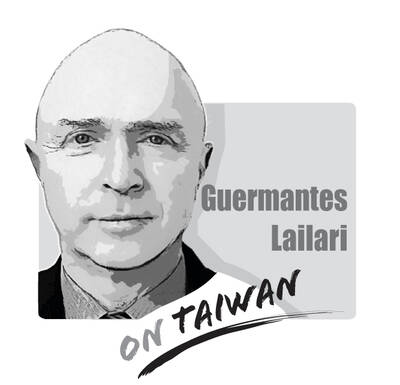The High Prosecutors’ Office in August arrested a lieutenant colonel surnamed Hsieh (謝) on suspicion of being recruited by Chinese operatives to defect to China in a Boeing CH-47 Chinook military helicopter.
Hsieh was reportedly to land on a Chinese People’s Liberation Army Navy warship when it approached the median line of the Taiwan Strait. After completing his defection, he was to receive US$15 million.
However, prosecutors arrested Hsieh before he could do so.
If he had succeeded, it would have been the first defection since then-major Lien Hsien-shun’s (林賢順) defection in 1989 when he fled in an F-5E jet from his base in Taitung.
As the Aviation and Special Forces Command only has eight CH-47s, they are considered high-value equipment, not to mention that they have extra significance because they are used to carry the national flag over the Presidential Office Building on Double Ten National Day.
The case also involved the leaking of the “0221” confidential project to China, a military strategy overseen by the president.
The events show that the Whampoa Military Academy and its history with the Republic of China (ROC) are being exploited by the Chinese Communist Party to buttress its idea that the two sides of the Taiwan Strait are “one family.”
It has been inviting retired generals to lavish parties or golf events in China to develop organizations in Taiwan.
When the Democratic Progressive Party took office in 2016, it respected the military by not interfering in its ideology and historical perspectives. This has enabled retired generals to be easily bribed by China, resulting in treason and spying.
The commander in chief has three obligations:
First, establish a military history based on the Taiwanese perspective. By the time Chiang Kai-shek (蔣介石) retreated to Taiwan in 1949, many of those who attended the Whampoa Military Academy, which was based in Chengdu at the time, either died in battle or surrendered. Those who made it to Taiwan were shunned by the KMT.
The academy should regard former commander-in-chief of the ROC army Sun Li-jen (孫立人), who re-established the academy in Kaohsiung’s Fengshan District (鳳山), as the founder of a new entity and the new site as its inception.
Second, focus should be placed on the modern history of Taiwan, including Penghu, Kinmen and Lienchiang counties. People should pay attention to the highlights of modern history, such as the Battle of Guningtou, the 823 Artillery Bombardment, the 814 Kinmen Aerial Warfare, the Third Taiwan Strait Crisis and the Fourth Taiwan Strait Crisis last year.
Third, the commander in chief should preside over the anniversary of the academy.
With the anniversary marking the most direct connection between deep-blue factions and China, former presidents Chen Shui-bian (陳水扁) and Lee Teng-hui (李登輝) regarded participation as an important symbol of their command over the military. This is an aspect of the presidency that even pro-China supporters cannot change.
With the academy to mark its centennial next year, the new president should use the opportunity to shape the discourse, put further emphasis on military education and clarify the history of the academy.
It is high time all ties were cut with China and for the Kaohsiung facility to be regarded as a new beginning for Taiwan’s military history.
Only then can Taiwanese counter China’s “united front” tactics and establish a military history of their own.
Chu-Ke Feng-yun is a military blogger.
Translated by Rita Wang

“History does not repeat itself, but it rhymes” (attributed to Mark Twain). The USSR was the international bully during the Cold War as it sought to make the world safe for Soviet-style Communism. China is now the global bully as it applies economic power and invests in Mao’s (毛澤東) magic weapons (the People’s Liberation Army [PLA], the United Front Work Department, and the Chinese Communist Party [CCP]) to achieve world domination. Freedom-loving countries must respond to the People’s Republic of China (PRC), especially in the Indo-Pacific (IP), as resolutely as they did against the USSR. In 1954, the US and its allies
A response to my article (“Invite ‘will-bes,’ not has-beens,” Aug. 12, page 8) mischaracterizes my arguments, as well as a speech by former British prime minister Boris Johnson at the Ketagalan Forum in Taipei early last month. Tseng Yueh-ying (曾月英) in the response (“A misreading of Johnson’s speech,” Aug. 24, page 8) does not dispute that Johnson referred repeatedly to Taiwan as “a segment of the Chinese population,” but asserts that the phrase challenged Beijing by questioning whether parts of “the Chinese population” could be “differently Chinese.” This is essentially a confirmation of Beijing’s “one country, two systems” formulation, which says that
On Monday last week, American Institute in Taiwan (AIT) Director Raymond Greene met with Chinese Nationalist Party (KMT) lawmakers to discuss Taiwan-US defense cooperation, on the heels of a separate meeting the previous week with Minister of National Defense Minister Wellington Koo (顧立雄). Departing from the usual convention of not advertising interactions with senior national security officials, the AIT posted photos of both meetings on Facebook, seemingly putting the ruling and opposition parties on public notice to obtain bipartisan support for Taiwan’s defense budget and other initiatives. Over the past year, increasing Taiwan’s defense budget has been a sore spot
Media said that several pan-blue figures — among them former Chinese Nationalist Party (KMT) chairwoman Hung Hsiu-chu (洪秀柱), former KMT legislator Lee De-wei (李德維), former KMT Central Committee member Vincent Hsu (徐正文), New Party Chairman Wu Cheng-tien (吳成典), former New Party legislator Chou chuan (周荃) and New Party Deputy Secretary-General You Chih-pin (游智彬) — yesterday attended the Chinese Communist Party’s (CCP) military parade commemorating the 80th anniversary of the end of World War II. China’s Xinhua news agency reported that foreign leaders were present alongside Chinese President Xi Jinping (習近平), such as Russian President Vladimir Putin, North Korean leader Kim